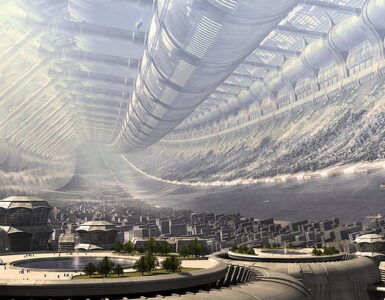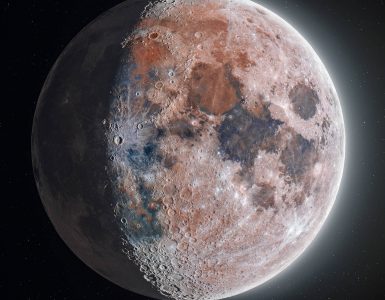by A’liya Spinner
Can we survive in the most inhospitable habitat of all?
Chariot Neptune
One of the water recyclers has been down for days. That was all Elise could think about as she tended the aeroponics bay. It was less noticeable elsewhere on the Chariot Neptune, where the only water leaking into the environment was in the form of sweat. But here, where regular spritzes of mist fed nutrients directly to the exposed roots of the crops growing in lattices all around her, the humidity was almost stifling. This would be a normal day on Earth, she mused as she pulled her weightless body through the garden. But eleven years in perfect dryness really warps your perception on things.
Most of the crew was worried about the water, even though Chariot Neptune was outfitted with enough recyclers that, according to the builders, three could fail before clean water became a concern. Elise chose to believe that promise, and tried not to think about all of the water molecules they weren’t recovering. Oxygen levels were pristine, and the garden was producing more protein-rich algae and fresh fruits than she’d projected. The strange flu-like illness that had befallen the chief engineer and one of his assistants seemed to have been cured without breaking into their limited store of antibiotics. Everything was functioning smoothly.
Still, Elise made sure to turn down the misters on her way out of the aeroponics bay. Good luck was just that— luck. It was important to take all necessary precautions, too, to ensure they got to their destination with enough water to comfortably support the crew and onboard ecosystem. For eleven years the Chariot Neptune had survived on its own, receiving only the occasional transmission from Earth with advice or encouragement. With only a year to go until they reached their destination— orbit around gas giant Neptune— and began the process of converting their habitat ship into a permanent station using resources mined from Neptune’s resource-rich rings, the crew was beginning to get a little restless. The geniuses at home had spent so long determining how to keep the crew of Chariot alive that they’d forgotten to account for boredom.
Being bored is the best I can hope for, Elise knew, vowing not to take the fact that the ship was healthy and functional for granted. She left the garden behind and pushed herself gently through the corridors, almost as used to navigating microgravity as she’d once been to walking the streets of her hometown. The crew had taken to a bit of interior decorating, fastening drawings of their favorite Earth landmarks or animals to the walls. Paper was another commodity they didn’t have much of, but the captain had understood the need for a little nostalgia and creative expression. Maybe the next wave of Neptunian researchers and colonists would bring extra sketchpads with them when they arrived in roughly fifteen years, and the crew could add drawings of their favorite sights from the Jovian gas giant to the corridors of what would then be the Chariot Neptune Station.
“Attention, please.” The intercom system blared to life, and Elise caught herself on a bulkhead, waiting to hear what it had to say. “This is a reminder that today is our monthly cleaning day. To conserve water, we will be doing a reduced wash on all fabrics and equipment in need of cleaning. Please bring anything you would like washed to the sanitation module. Anything you do not bring by 1900 hours will have to wait until next month. Thank you.”
That’s right. Elise pushed off again, launching herself down a side corridor towards the sleeping module she shared with two other women to gather her soiled clothes and dirty gardening tools. Back when she’d served on Earth-orbital stations, fresh clothes and equipment were delivered regularly, to cut down on water and chemical waste in space. Unfortunately, Chariot Neptune didn’t have that luxury; they had to do their own laundry, and on a budget. It could be worse, of course— if they were having a serious water shortage, they wouldn’t be able to wash their clothes at all. That would have been seriously unpleasant.
Overall, life on the ship wasn’t too difficult, and had been relatively smooth over the eleven years they’d been barreling along towards the distant Jovian world. It could be uncomfortable at times, and learning to live with only what they could produce and recycle had been a hard adjustment from life on abundant Earth. But the Chariot Neptune was well-equipped and well on its way to its destination, and Elise hoped that their success proved to the world they left behind that humanity was ready to expand beyond their homeworld. They were paving the way for a new form of human life— life amid the stars.
Self Sustainability
Life on Earth has become increasingly interconnected, moving crops and manufactured goods to consumers across the world. We get nearly everything we need from somewhere else— our food, clothes, houses, medicine, and even our water is provided by the global infrastructure that ensures we no longer need to live like nomadic hunter-gatherers, thriving on even the most infertile lands and in crowded, bustling cities. But life off of Earth will not have access to these modern amenities, and in an ironic way, our future space colonies will have to resort to the ancient lifestyle of nearly complete self-sufficiency.
There are already people living in space, on the International Space Station. However, the ISS cannot be called self-sufficient; most of the drinkable water and breathable oxygen aboard the station— not to mention food, clothes, and medical supplies— are delivered from Earth. In the same vein, waste products and research are taken off of the station to keep the station clear and clean. This is by no means a quick or simple process, either. It takes days from launch for supply shuttles to safely connect with the ISS, and unloading the cargo can take multiple months. Once finished, the astronauts aboard the station often have to wait several more months for the next shipment of clean clothes, fresh food, and new oxygen. While this impressive length of time between shuttles is surely a testament to the tenacity and resourcefulness of the people living aboard the ISS, the critical cargo delivered by Earth— and the great volume that it arrives in— is evidence that the International Space Station is far from the self-sufficient space colony we often dream about in fiction.
What can we already do?
As more and more public and private eyes turn towards spacethe stars, the idea of a more robust and industrious space colony has become increasingly prevalent. But, as established, our current extraterrestrial habitat is nowhere near the level it would have to be to fulfill those expectations. Fortunately, since the creation of the ISS, scientists have begun to develop new and exciting techniques that can hopefully be implemented in the orbital colonies that eventually follow the International Space Station, which is slated to be decommissioned by 2031.
Perhaps the most exciting of these discoveries addresses one of the pivotal concerns of a self-sufficient colony— growing food in space. Vegetables have already been grown in space, but it requires soil or an equitable growth medium as on Earth, and the process can only be done on a small scale due to sanitation and resource issues that it raises. The solution is to do away with dirt altogether, and master the techniques of hydroponics (planting in inert materials where roots are exposed directly to nutrients) and aeroponics (where roots are misted with nutrient solutions), which are already being perfected on Earth to produce space-and-resource conscious crops. But soil alternatives, of course, aren’t the only step to plant growth in space. In order to cultivate a healthy garden in space, the minor (and microscopic) components from Earth must also be integrated. The microbes that help to break down human waste into a usable resource for plants, purify water for plant and human use, and generally keep us healthy by coexisting with our bodies and crops will also need to be included, and in just the right concentrations to simulate a working ecosystem. Luckily, we may have stumbled into some of those microbes already; in the 2010s, researchers aboard the ISS discovered four unknown bacterial strains that had accidentally come aboard the station through plant-growing experiments. These strains were hardy enough to survive in the hostile conditions of the ISS, and required few nutrients to multiply, leading many scientists to believe that these microbes possessed useful genetic determinants for choosing which bacteria will make good candidates for promoting plant growth in stressful conditions. Hopefully, these innovations will create a constant food source that can be augmented by, but not reliant on, shipments from Earth.
What still stands in our way?
The oxygen and water recycling capabilities of the ISS are already admirable, creating fresh oxygen from electrolysis (splitting water atoms), and collecting and purifying liquid in basically all of its forms. These processes will be further streamlined with the addition of healthy, onboard ecosystems, as microbes clean water and plants produce oxygen while absorbing carbon dioxide waste from human respiration. With the development of a new, oxygen super-producing algae (that can also be eaten by astronauts as a source of protein), breathable air may soon become fully replenishable, but even algae needs water to grow, and as of now we have no way to create a completely self-sustaining water cycle aboard a space station, and new water must be imported from Earth. We also have no way to synthesize water from renewable materials that can be gathered from raw space. Rather, we would likely have to “catch” water from ice-and-water rich asteroids and comets, especially when considering colonies that orbit celestial bodies other than Earth. This, of course, is also currently out of the realm of possibility, and hopefully will be replaced by a more feasible, functioning water recycling system that does not rely on fresh shipments from Earth.
Other There are also day-to-day issues with permanent space habitation includethat are not often thought about— such as the impactwhat orbital living has ondoes to the human body, and how to keep astronaut colonists alive for a lifetime. One such example is the potential for bacterial and viral infections in space; being in microgravity weakens the immune system, and studies show that bacteria have increased virulence in space, making antibiotics less useful. A self-sustaining station wouldn’t be exposed to the pandemics of Earth, but even the healthiest of astronauts would bring with them dormant viruses in their bloodstream and the microbes of their intestinal system, any of which could potentially cause widespread illness in a closed-circuit space station. Then there’s the issue of more serious illnesses, such as cancer, which could develop in greater frequency due to the constant bombardment of radiation from space, heart disease, or physical injuries. Shuttling the sick and hurt back to Earth may be the only way to get people the care they need (it would be nearly impossible to get the medical equipment needed to handle life-threatening illnesses into space), but this method of healthcare is costly and inefficient, and certainly not self-sufficient. Revolutionizing treatment for serious health conditions, as well as further research into the poorly-understood behavior of bacterial and viral infections in microgravity, will be required before living for decades in a space colony becomes feasible.
Space Habitats In Progress
As with most seemingly impossible dreams, there are already those who are working to see them become a reality, especially in the private sector. And while perhaps these orbital colonies aren’t yet being designed to be completely cut off from Earth, many of them are already, in theory, a step above the International Space Station in terms of self-reliance.
Starship
Starship is a working SpaceX project which aims to mass-produce the titular starships for extremely cheap ($5 million, pennies by spaceflight standards). These giant ships, each bigger than the ISS and able to hold many more passengers than the ISS can hold astronauts, are also designed to be reusable, and can orbit at a low enough altitude to minimize risk of radiation. Although SpaceX largely intends for Starship to be a vessel that carries passengers, equipment, and possibly even colonists to the moon and Mars, such a spacious and resilient ship also has habitable potential, especially if linked together in low orbit. Starship has the most carrying capacity of any rocket before it, able to house an onboard ecosystem and perhaps enough of the rudimentary medical and everyday supplies (clothes, repair equipment, utensils) needed to found an orbiting colony of humans. Certainly soon, and especially after the death of the ISS, Starship and habitable ships like it will become at least temporary homes for astronauts and scientists studying the effects of microgravity in orbital laboratories, which will test their ability to sustain colonists on board without constant refuels from Earth. At the same time, the development of Starship may ultimately make the idea of self-sufficient stations obsolete if they can make the cost and frequency of supply shipments from Earth effectively negligible for the companies who create the next generation of orbiting space stations.
Voyager Station
The Voyager Station is a planned orbital hotel that aims to turn spaceflight from an uncomfortable, scientific exodus to a luxury vacation. Orbital Assembly, the firm behind the planned station, promises enough gravity to sleep, shower, and walk comfortably around habitat pods that can be “rented for a week, a month, or purchased as a vacation home,” and can house between two and sixteen guests. It will contain an on-board gym, a restaurant with regular shipments of fresh food, and a bar. It’s a lot to swallow, and the projected 2027 opening date seems optimistic at best and impossible at worst, but Voyager Station’s proposed promises amenities that will be crucial to long-term habitation in space. One particularly important detail is artificial gravity— even a gravitational pull as light as the moon’s (which is what is proposed by Voyager) will drastically reduce the stresses of microgravity on the human body. Gyms, showers, and regular beds will also reduce health risks, and help keep visitors clean and comfortable, which minimizes sickness and the physical effects of fatigue. Of course, not being designed to be self-sufficient means that Voyager Station will invest more in luxury and artificial gravity than revolutionary water, oxygen, and food replenishment systems, but if it does go forward with construction, its design will lay the groundwork for more advanced, long-term settlements in low orbit.
To What End?
Why is self-sufficiency in space the ultimate mission? Well, given the immediate goals and plans of orbital space stations, it isn’t, and likely shouldn’t be. However, advancements in self-sufficiency improve the efficiency and safety of almost all space missions, regardless of whether or not they plan on receiving frequent shipments from Earth. Should a resupply mission to Voyager Station fail, as it did three times in a row for the ISS, crew members and guests need to be able to survive on regenerating oxygen, water, and food stores aboard the station. Making months-long research trips aboard SpaceX’s Starships cost effective will likely require little to no resupplies from Earth until the experiments are finished. The same is true of the seven month trip to Mars that will someday be undertaken by humans, during which rendezvous with supply ships will be nearly impossible. Future research and observation stations orbiting Mars or other solar system bodies will also be too isolated to expect regular shipments from Earth more than once a year, if at all, and thus will need to be as self-sustaining as possible.
Someday, humanity may set out to colonize farther systems, which will require multi-generational habitat ships, capable of supporting life from conception to death at old age. But the technology needed to sustain an undertaking of that scope is far beyond our current capabilities. In the meantime, we can use advancements in microgravity agriculture, oxygen recycling, and quality of life to increase the length and reduce the cost of our journeys into space, and make travel beyond Earth more accessible for both scientists and dreamers alike.









